 |
||
|
||
| ||
AMD chipsets were always standing apart on the market. We have used to the fact that processors and chipsets are always produced by Intel, and AMD is something different... Besides, both the AMD-750 "Irongate" and the today's AMD-760 as compared with competitors look pale - there are neither high-efficient buses between a north and a south bridges, nor various up-to-date features in the south bridge. Even AMD call it "ascetic". But let's consider the problem from the standstill of AMD. It is no secret that the company decided to start production of chipsets to back their CPUs. They say that if other companies can't manage their task, motherboard manufacturers can always purchase chipsets for AMD's processors at AMD's stores. I think that all peculiarities of AMD chipsets are hidden in this approach. The company launched the first "slot" Athlon, and right after it - the AMD-750. Yes, it lacks for AGP 4X, UltraATA/100, hardware monitoring, PC133 SDRAM support. But! - 1) there is a chipset for the processor; 2) it provides a stable work at the minimal downgrade in performance. The VIA Apollo KX133, released right after it, supported the SDRAM at 133 MHz, but it helped it little - in some cases the AMD-750 based boards turned to be even faster! Besides, not all boards on the KX133 were compatible with the Slot A Thunderbird, and there were some "socket" models on the AMD-750 (Gigabyte GA-7IXE4). The AMD-760 kept on the good old "ascetic" tradition. It was just a chipset for high-end machines. A usual PC100/PC133 SDRAM wasn't supported, installation of the Athlon CPUs at FSB 100 (200 DDR) MHz doomed the whole system to a considerable performance decrease since the memory, whatever it could be would work at the same frequency. That is why an AMD-760 based board makes sense only if it is equipped with one of the latest Athlon models intended for FSB 133 (266 DDR) MHz and PC2100 DDR SDRAM. It explains why they made no efforts to make the chipset compatible with a standard 4-layer design, and why an expensive 6-layer one was chosen. And as for a south bridge, the AMD has a right approach - each mainboard manufacturer can make a choice: either to install an ascetic AMD-756 or an advanced VIA VT82C686B south bridge or something else... But let's consider all 7 contestants one after another. One of them is the ASUS A7M266 which is not produced any more. FIC AD11GigaByte and FIC were the main partners of AMD in development and promotion of mainboards on the AMD760. The name of the former is associated with the AMD760 since they was the first to start selling the 7DXC board based on the earliest revisions of the chipset and supporting only Athlons with a 200 MHz bus. Besides, the GigaByte engineers were constantly improving the design of the today's 7DX, which revision 3.0 says how much time was spent. As for the latter, I can state that they delivered boards to their OEM customers nearly more than those supplied by Gigabyte, and many consider the AD11 the best among all AMD760 boards. First International Computer is a member of the largest in Taiwan Formosa Plastics Group together with VIA Technologies and NANYA, it has a solid financial support and usually do not service end-users, implementing primarily large OEM-orders (including those for ready system manufacturers). That is why packed boards have boxes of a simple design: yellow-orange with a writing "1ST Mainboard". The board is supplied with FDD, 40-conductor and 80-conductor IDE cables, a user manual and 2 CDs. One of them contains drivers not only for AMDxxx, but also for VIA and Intel chipsets, and a series of proprietary programs for a software overclocker in order to increase functionality of the product and make it easy to use. All the software is included in the soft-hardware complex called NOVUS (inNOVation for USers). The only really helpful feature is a possibility to make settings in BIOS from any program at any time. The second disc contains Norton Ghost, Norton Antivirus and Norton Virtual Drive. And a daughter board Audio Alert II, which is also included in the NOVUS and informing aloud on bugs in the system, is optional, and our complete set lacks it. By the way, it is inserted in a special 9-pin connector, speaks aloud and has an onboard Flash-memory. 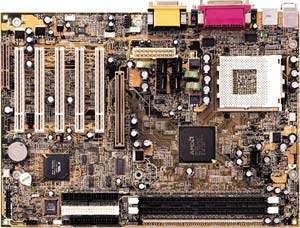 The layout of the board is well thought-out. There are only two drawbacks: the board has only two connectors for coolers, one of them being on the left edge and intended for chipset cooling. The second downside is that the power supply connector is located so that its cable blocks the CPU's fan. What I really like is a voltage transformation unit; there is an effective scheme of three-phase supply, each of 6 transistors being equipped with a heat sink. The benchmark results proved the AD11 stability to be perfect. The socket and capacitors around it are located so that the cooler installation makes no problem. Two blocks of DIP-switches are intended for a forced changing of a CPU multiplier in the range from 5 to 12.5V and Vcore in 0.025V steps. A necessity to install terminators behind the memory slots (which are usually 2) and urge towards reducing the size of the PCB make many manufacturers move HDD and FDD connectors to the left side of the board. The real convenience is that the connectors are located not too close to each other. The slots' set includes 1 AGP, 5 PCIs and 1 CNR, shared with the last PCI. The sound is realized with the AC'97 codec ALC200. Besides, the board features a built-in speaker. The BIOS FIC AD11 is based on the AWARD 6.0 and has a plenty of settings, especially as far as the memory is concerned. The DDR has 7 basic parameters which define its efficiency. The most important is CAS latency. For the detailed information refer to www.jedec.org, we will just give you their names: ph limit, idle limit, Trc timing value, Trp timing value, Tras timing value, CAS latency, Trcd timing value. They are all can be adjusted in the BIOS. The block of voltage changers of the processor and a forced CPU multiplier change is under control of DIP switches. Jumpers switch the base frequency of the system bus: 100 or 133 MHz. The system bus frequency in finer steps can be changed in the BIOS. After setting the base frequency you can choose the following variants of FSB frequencies and the memory: 100, 103, 105, 110, 113, 117, 133, 138, 140, 144 and 150 MHz. MSI K7 Master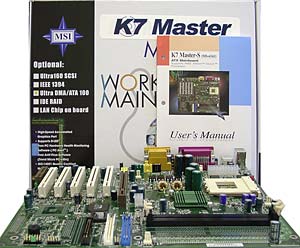 The MSI's board ships in a huge box, inside of which you can find the "MSI Workstation Mainboard". Apart from it the box contains 2 FDD and 1 80-conductor IDE cable, 1 CD with drivers and utilities, a user manual in English and a packet with two stickers - "Geared by MSI" (for a front panel) and for one with explanation of the D-Led indicator. The CD contains one interesting program called Live BIOS, which allows updating your BIOS without loading the DOS. Since the board is of the Workstation class, you can't connect two PCs via USB, that's why additional USB brackets and a cable are not supplied. It is interesting that the board and other stuff in the box are separated with cardboard paper of which you can assemble a calendar-house. The house looks not very pleasant, however, and we threw it out without even taking a photo of it. The board, on the contrary, looks very nice and works excellent. The K7 has great dimensions - 305x259 mm. You might know that with the Registered DDR DIMM used the AMD760 chipset supports 4 DIMMs and 4 GBytes memory, but our samples has only 2 DIMMs unsoldered. Besides, the K7 Master has the same PCB design as that of the K7 Master-S, equipped with dual-channel Ultra 160 SCSI-controller on the Adaptec 7899. Despite its huge size, and, therefore, a higher price and less convenience in installation, a user can choose among a usual board and a version with a SCSI controller. It is very important, since the AMD760 chipset suits workstations the best way. Another advantage is an AGP Pro slot, supplied together with an additional 4-pin power supply connector, the same as on Pentium 4 boards. Undoubtedly, even the worst power-hungry multichip professional accelerators will work flawlessly here provided that the power supply unit is enough. What else is necessary for a real Workstation? It is stability, since rendering and video editing can take much more than 1 day... The K7 Master has no problems here, since it has the newest scheme of the dual filtered power supply when 8 transistors are used instead of 4. 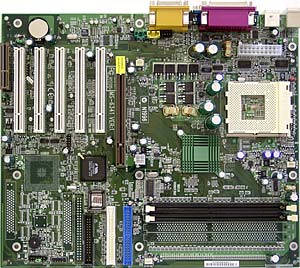 The socket is located near the left edge so that installation of any cooler won't make problems. Behind the Socket there is an ATX-power connector. Apart from the AGP Pro, the board sports 5 PCIs, and 1 CNR, shared with the last PCI. IDE and FDD connectors are located athwart to DIMMs but at the same time they don't prevent installation of full-size cards in expansion slots, plus they are located not too close to each other not to hamper connection of cables. The side of the AC'97 sound based on the VIA VT1611A is covered with a black speaker like one on the FIC AD11. There is also a series of 4 LEDs, D-Led. As far as exhaustiveness of the information is concerned, 7-segment EPoX or Abit indicators are better, though the D-Leds can also help to solve the problem. The board lacks for any DIP-switches, all settings are to be made in the BIOS. Yes, you are right, it is AWARD. The bus frequency is changed in the BIOS, but the range is not very wide - 100, 103, 105, 110, 113, 117, 133, 138, 140, 144 and 150 MHz. The board allows to lift or to reduce the processor's voltage only by 0.1V in 0.025V increments, it means that a processor working at 1.75V can be set to voltage values within the range from 1.65-1.85V. The processor's multiplier can be also changed in the BIOS, although it works a bit strange. For example, for a 1.33 MHz/266 MHz processor they offered us multiplier values only in the range from 10 to 12.5. For memory configuration all 7 adjustments are available. ASUS A7M266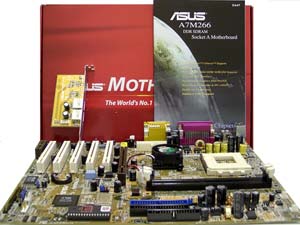 There is not much that changed from the our February digest when we considered the ASUS A7M266 board, though there are some important enhancements. The boards weren't produced for a long time (they are already taken out of the production, and now ASUS will promote only A7A266 and A7V266 models), that is why the developers didn't work hard on the box. Apart from the motherboard, a bracket with two additional USB ports, USB, FDD, 40-conductor and 80-conductor cables a red box with a writing "Motherboard Manufacturer N1" contains only a user manual, a CD and a sticker with a pegasus. As for boards on the chipset with DDR memory support, the situation is that manufacturers can't draw the cost of them close to, for instance, the KT133A. Therefore, we have now expanded boards' possibilities at the expense of cheap additional controllers for realization of the external IDE RAID, normal sound etc. That is why today's descriptions of mainboards from ASUS and Gigabyte will be very similar to those published two months ago. The ASUS's board has a normal 4.1 sound from C3D on the CMI8738 chip - such solution will increase the system performance by several percents relatively to an integrated AC'97 codec in applications using the sound. The 3Com 3C920 network adapter, promised in the next revisions of the board hasn't yet appeared. The company took the A7M266 board out of the production. That is why we won't see boards with a letter "L" in the name. And a usual A7M266 board can still be bought, its new revision has even undergone considerable changes. The maximum possible number of DIMMs has decreased from 4 to 3, but anyway there are only 2 unsoldered. Besides, voltage changes implemented according to the traditional scheme are also changed to some extent. The ASUS is the only board today with a usual power supply, but it didn't affect the stability of the system, though the Athlon 1.33 GHz is too power-hungry. 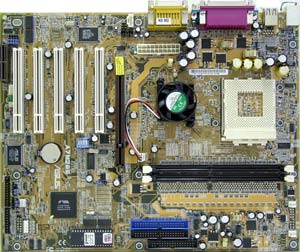 The board's stability is backed by a normal cooling system with a warm air tap function, though I think it is too excessive - the board doesn't heat so strong. The board sports an AGP Pro slot for video cards with increased power consumption. This model, unlike its predecessor, has a switch for a CPU multiplier. It is a good advantage together with the parameters of other components remounted intact (frequencies of memory, AGP and PCI buses). Among other overclocking possibilities there are 4 blocks of switches - one is for FSB frequencies (100, 103, 105, 110, 115 and 133), the second one is intended for the Vcore (from 1.1 to 1.85V in 0.05V steps), the third one is meant for the Vmem (2.4, 2.5 and 2.6B), and the last one is for the chipset's voltage. The first two are duplicated in the BIOS, which is based on the Award Medallion BIOS v.6.0. Here you can also set memory parameters, although the adjustment is not so fine as in case of controllers (3 parameters), set interrupts for PCI slots and AGP modes - in all other respects it is a typical BIOS from Asustek with a wide choice of settings. Here you can even adjust the Super Bypass Wait State, while other boards don't allow it. The frequencies can be widely changed in the BIOS - from 100 to 180 MHz. Gigabyte 7DX The 7DX board is one of the last to be packed in a standard blue box. In the nearest time the company will introduce new-designed boxes in 5 colors. The 7DX rev3.0, we managed to receive, is introduced by AMD as a standard of stability and performance. However, there is also a fly in the ointment: the board we tested was produced by request of MicronPC and had an empty BIOS, though when started, it regularly showed the internet address of Micron. Nevertheless, the proprietary box contains a FDD, 40- and 80-conductor IDE cables, a diskette and a user manual which insisted that the board was the 7DXC and lacked for a 266 MHz bus. But the board still had a 266 MHz bus, as well as a three-phase power supply and a fan on the processor's heat sink. The heat sink, though, is attached with a transparent sticker, which heat-conducting properties are questionable. 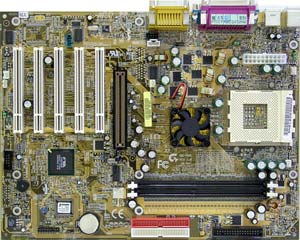 Gigabyte has integrated an alternative cheap sound solution based on the CT5880 chip from Creative which allows for connecting 6-channel audio systems. The AGP slot has a clamp for cards, what is very convenient since some cards are trying to jump out of the slot. It is interesting that the Suspend to RAM function is realized with a jumper on the motherboard, unlike on other boards where this function is realized in the BIOS Setup. Another interesting feature is a realization of unbuffered or registered memory modules' support - here we again can see jumpers on the mainboard, it might be difficult for users far from such things. The 7DX is like an intermediate stage in the company's returning to overclocking functions realized not in the Easy Tune but on the hardware level. The Gigabyte 7DX has a block of DIP-switches for FSB frequencies: 95, 100.7, 100.9, 103, 105, 110, 115, 133 MHz, this function is not duplicated in the BIOS, and frequencies can be adjusted either with jumpers or with the proprietary utility from Gigabyte - EasyTune III. And voltage supplied to the chipset and memory can't be changed. Besides, there is no possibility to set a processor's multiplier. The only the BIOS can be proud of is memory settings. On the whole the board seems to be a solution for a user once bought a computer and decided to change nothing in it. EPOX EP-8K7A+ The boards from EPoX are well known for their excellent speed characteristics, high implementation quality and a rich set of additional functions. Today we will deal with the EP-8K7A+ board, the oldest one in the series of the EPoX boards on the AMD 761. As usual, the "+" in the name means an integrated IDE RAID-controller based on the HPT370A from a well-known manufacturer HighPoint. The controller allows for connecting hard discs with an ATAPI interface and working modes up to UATA/100 (of course, it is back compatible so that you can connect not so efficient discs). In case of one disc, it will work in the maximum possible mode. And in case of two and more discs there is a choice. You can use them just as different hard discs, or you'd better combine them into one logical disc with the help of the RAID 0 mode (stripping), when data are recorded on one and then on the other disc by turns, thus considerably increasing the speed of disc subsystem. Users who are primarily interested in the high fault-tolerance, may choose the RAID 1 mode (mirroring), where all data are recorded on the both discs. For users who want both the high speed and high reliability it makes sense to use 4 hard discs in the mode RAID 0+1. In case of such combination you won't fall too far behind high-efficient HDDs with the SCSI interface in speed, the reliability of the system will also increase. And a price for the hard discs with these two interfaces is much lower than that with the SCSI. This time the box of the EPoX board is blue with the motherboard and the logo pictured on the front side. The box contains a user manual in English, a CD with different programs, a FDD cable, 1 80- and 1 40-conductor IDE cables, and a bracket for the rear panel of the computer with two USB ports.  The CD contains drivers, Adobe Acrobat Reader v 4.05 program for documents in PDF format, the Norton Antivirus 2001, the Norton Ghost 6.03, and utilities for a system monitoring from VIA (VIA Hardware Monitor) and from EPoX (USDM - Unified System Diagnostic Manager). There is also a utility for measuring processor's frequency right from the Windows - the Boostek program. The board has the most popular slot combination - 6 PCI and 1 AGP, the board's layout is well thought-out and convenient, but for CD-in, AUX-in and Modem-in connectors located right above the first and the second PCI slots, which can make some problems, all other components are easy to reach. The board is equipped with two 7-segment LEDs for for indicating how the board passes the POST procedure, and a new POSTMAN technology to voice what problems you are facing. The EPOX board, as usual, has an AGP slot with a clamp in order to prevent accidental jumping of the card out of the slot. 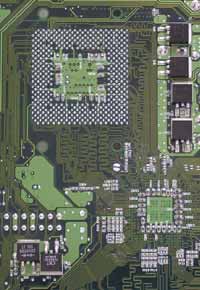 In order to increase the stability the board sports a dual filtered power supply. For a normal temperature mode 4 transistors have heat sinks, and the other four are hiding so that you can't find them at once :) They are located on the back side of the board, so be careful when installing the mainboard. The chipset's heat sinks are cooled with the device on a bearing from AAVID. The board has a high fault-tolerance, it passes Stress-tests excellently. It's quite another matter that the year in the Windows was set as 14999, and a half of applications refused to start. After the forced adjustment of the year no other strange thing could be noticed. The board has several blocks of DIP-switches to change such parameters as a processor multiplier (from X5 to X12.5), a Vcore (max +0.4C in 0.1V steps), a Vmem (max +0.4B in 0.1V steps), and a base CPU frequency - 100 or 133 MHz. The intermediate frequencies can be set in the BIOS Setup with the description provided. The BIOS is based on the 6.0 version from Award, but it sports a great deal of settings to make your system as efficient as possible: memory settings, AGP ones, a possibility to change a processor's frequency up to 166MHz in 1 MHz steps. In order to configure the system in case of conflicts among devices you can manually change PCI interrupts marked for slots. In general, the board looks not that bad as compared with other contestants, but the tests will reveal its real performance. AOpen MK7A This company was among the firsts to pay due attention not only to quality and speed characteristics of mainboards, but also to their appearance. Today we have the MK7A board. It is the only board in our today's roundup with a MicroATX form-factor. Therefore, the board has less PCI slots - there are only three without any additional sporting features as an additional IDE controller etc. But the board doesn't become worse - it is just intended for another market sector - not for end-users but mainly for assemblers. That is why the manufacturer won't lean over backwards to achieve good looks - there'll be neither gold sputtering nor covering with a special vanish. That is why it makes no sense to provide wide possibilities of the system configuration. It is strange that the company decided to release a mainboard only of this format. Usually, a family of AOpen boards on the same chipset includes several models - this one, a mainboard of the ATX format, and a board of the same format with additional features - a network or IDE controller. But so far I haven't heard announces of other boards. 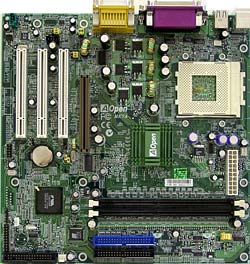 Despite its size the board is quite convenient, but for a CD-in connector which is located in front of the PCI slots - I understand that a codec is near and it's dull to dig more ways, but I think that they should have thought over the layout more properly. In spite of its microATX format, the developers decided not to save on a block of voltage changers - a scheme of a three-phase power supply provides a high stability. The board is equipped with several blocks of switches intended for quite traditional operations - to set a processor's frequency, to clear the CMOS etc. Besides, you can implement quite a rare function for mainboards - to switch on/off a final amplifier of the sound channel. In a traditionally-designed box there are 80- and 40-conductor IDE cables and an FDD one. Unfortunately, there is no bracket with additional USB ports - it can hamper usage of these ports, a connector for which is located on the board. Besides, the box contains a colorful poster with short installation instructions. A user manual is absent in a printed form, but it can be found on a CD in the PDF format. Besides, the CD offers drivers, utilities for monitoring, and a program for reading of descriptions of nearly all mainboards. Among the programs which don't relate directly to the board are Norton Antivirus and Norton Crash Guard, of 1998 and 1996, respectively. The board hasn't wide configuring possibilities - the jumpers can help only in changing the processor frequency (there are only two values, at that - 100 and 133MHz). The BIOS (based on the Award 6.0) provides all 7 adjustments concerning the DDR memory. I hope that a full-size board will feature possibilities of a forced changing of a multiplier and gradual adjustment of the system bus frequency... Chaintech 7KJD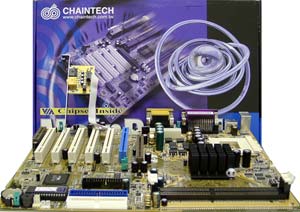 Chaintech retarted the release of the AMD760 based board, but on the other hand the board is nearly the best among all contestants. First, because of a sough bridge of the new generation - VIA VT8231, a complete analog of the V8233 in functions, which differs only in a usual PCI for connection with a north bridge instead of a V-Link bus with 266 MBytes/sec bandwidth. The board features a new ACR slot (Advanced Communication Riser), supports a 6-channel AC'97 sound and 6 USB ports. However, we can't test possibilities of a new ACR in comparison with the CNR due to lack of boards either for one slot or for the other. Besides, an integrated 6-channel sound turned to be unnecessary. The board is packed in a traditional purple box where you can find, apart from the board, a FDD 40- and 80-conductor IDE cables and an additional bracket with two additional audio-outs. Instead of a user manual there is only a sheet of paper with jumpers' functions. Besides, there is a CD-R with drivers. First of all, let's make clear the situation with the sound - why did an integrated sound turn to be unnecessary? Chaintech realized a completely hardware solution - the audio chip CMI8738 has received a support of a 6-channel sound. Moreover, board consumers don't need any more to make out of Line-In and Mic-in outputs for the second and the third pair of speakers on a software level. For normal outputs Chaintech supplies an additional bracket with two outputs which can simplify torments of beginners. The developers used a dual filtered power supply in the block of voltage changers, and a power supply unit is located next to a game-port. But I can't consider it a severe drawback, especially considering that the connector is adjacent to the voltage changers' block, thus eliminating additional pickups. The last trait ensuring high stability of the board is a gigantic heat sink mounted on the chipset - none of the competitors has such. 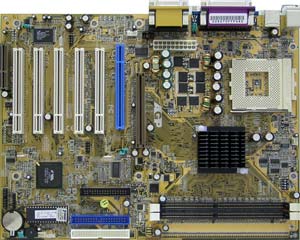 The socket is turned to the board's edge by its side where coolers get clamped not to damage the socket or the board. A well thought-out positioning of capacitors, far from the Socket-A, will allow for any installation of any cooler. With a block of DIP-switches one can change a CPU multiplier in a standard range from 5 to 12.5. An interesting set of slots riding on the new south bridge includes an AGP, 5 PCIs, a CNR shared with the last PCI, and an ACR slot located next to the AGP. The IDE and FDD connectors moved to the left side of the board are located parallel to DIMMs - it can bring about some problems: the cable might prevent installation and operation of full-size cards. That's strange that Chaintech, which usually installs two BIOS chips on serious boards, uses here only one. Nevertheless, let's look at its contents. The BIOS is based on the AWARD 6.0. The base bus frequency can be changed with a jumper, and in the BIOS the frequency is adjusted within the range from 100 to 165 MHz in 1 MHz steps. The voltage supplied to the processor can also be changed, the maximum that can be added over is 0.275V and it can be reduced down to 0.1V in 0.025V increments. All 7 adjustments concerning the DDR memory are available. On the whole, the BIOS of the Chaintech mainboard contains the most number of settings as compared with the today's contestants.
PerformanceAnticipating your questions about where the overclocking results are, I should note that the maximum the NANYA PC2100 CAS2 modules are capable of is 139 MHz at the mild timings. All boards (except the AOpen) reached this level without any problems, that is why the worst problem lies in a correct choice of the memory, and not of a board. The following test system was used to estimate the performance:
Software:
AMD-760 vs. VIA KT266/KT133AIn all VIA chipsets in question the AGP controller is realized better than that of its competitor, but the DDR-memory controller in the KT266 is much weaker. Unfortunately, the present-day mainboards on the KT266 don't allow for a correct work with the CAS2 DDR modules NANYA. Besides, it is still impossible to get a stable operation of the system in case of the Command Rate = 1T. That is why the data on the KT266 completely agree with the results published in our review. I hope the situation will change for the better in the near future, and you should remember that the KT266, as compared with the AMD760, does have some performance reserve to equalize their chances. 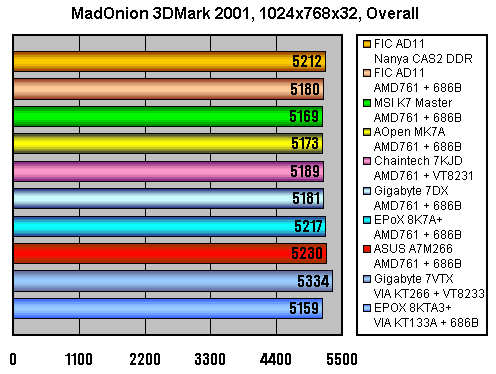 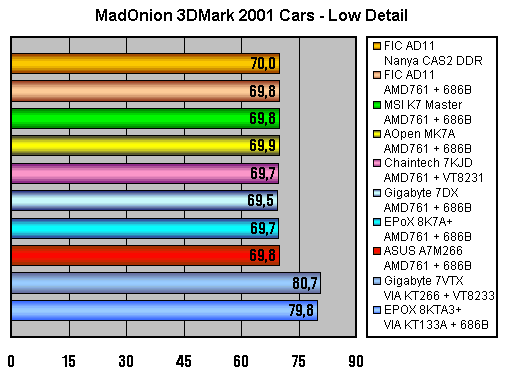 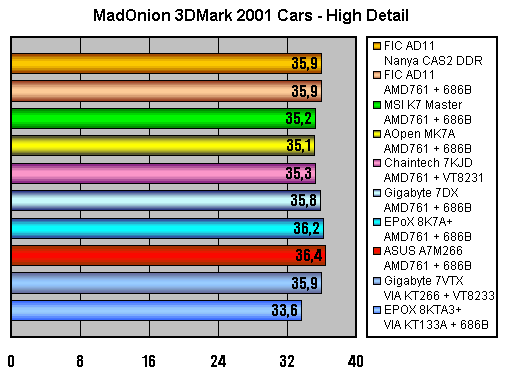 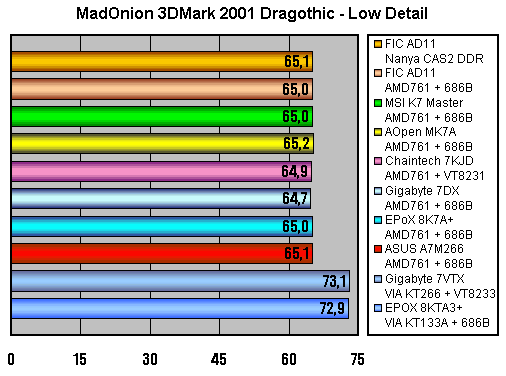 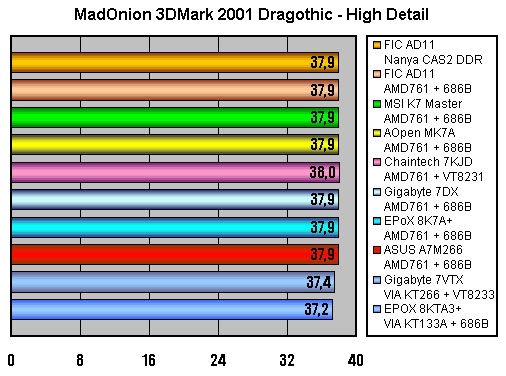 The VIA chipsets do not lose on average, the KT133A is just a bit behind the fastest board on the AMD-760, and the KT266 has even taken the lead. In the "Low Detail" mode all AMD-760 based boards fall even behind the KT133A, but as soon as we switch on the "High Detail" mode, the KT133A lags behind by a considerable margin, and the KT266 performs on a par with some not very efficient AMD-760 based boards. It is explained by the fact that the VIA has a faster AGP, and the AMD-760 has a better memory controller. Remember that the "High Detail" option of the 3DMark 2001 means mainly increase of the objects' complexity and of their number in the scene, that is why it is not only a video card which gets a heavier load, but also a subsystem "processor <-> memory". 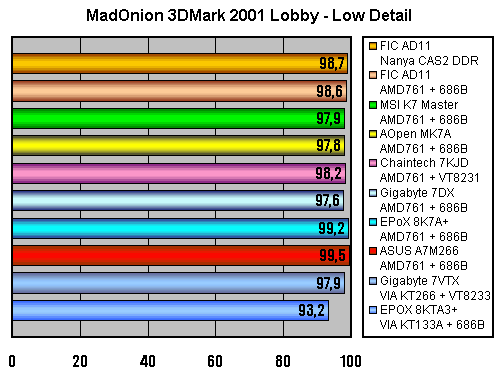 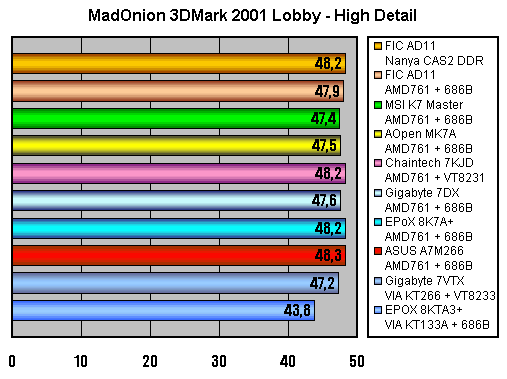 At the first sight the results are quite strange. Even at the "low detail" level both VIA chipsets perform not very well, and at the high detail level they are obvious losers. Scenes in the Lobby game-test are initially very difficult, even in the "Low Detail" mode, that is why we have obtained such results. The comparison results of the AMD-760 with the KT266 in this test show that the most part of the load in it is meant not for a video card. 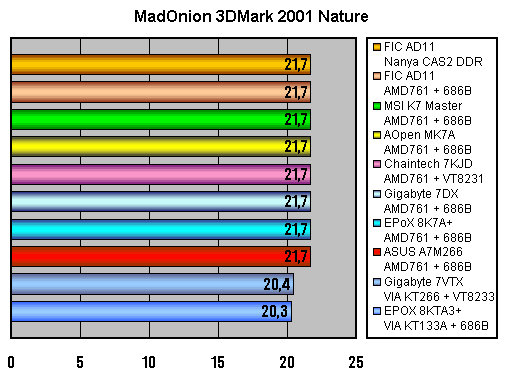 The Nature test has a highly complicated scene with a great deal of highly detailed objects, and the AMD-760 performs very well here, unlike both VIA chipsets. 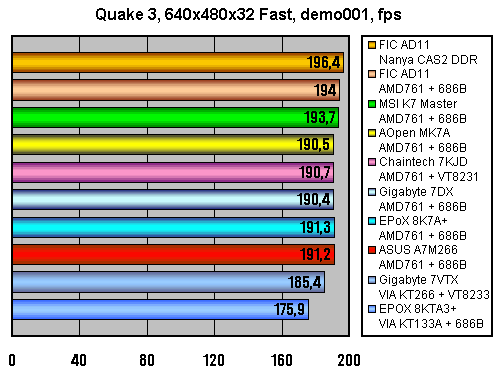 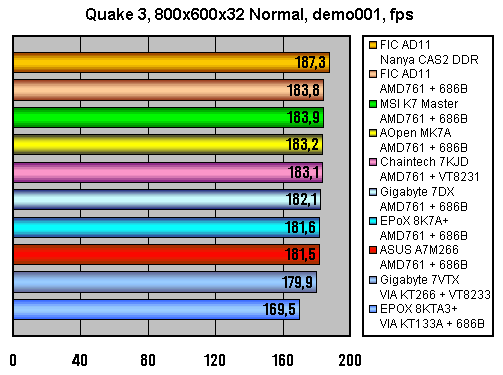  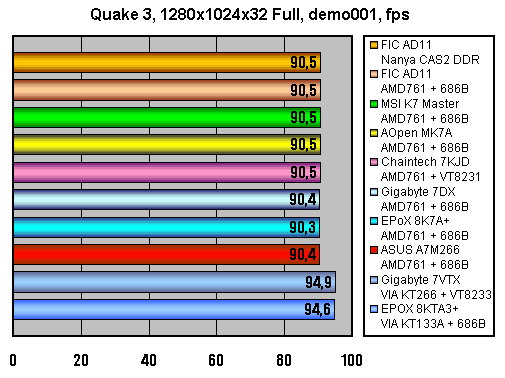 Here we have the same picture: when all depends on the speed of the subsystem "processor <-> memory", the AMD-760 is an unquestionable leader, but with increase of the resolution and detailing, it is beaten first by the KT266, and then by the KT133A. In the Quake III the number of objects in a scene and their complexity grow by a lower rate when migrating to higher modes, unlike the texture quality does. 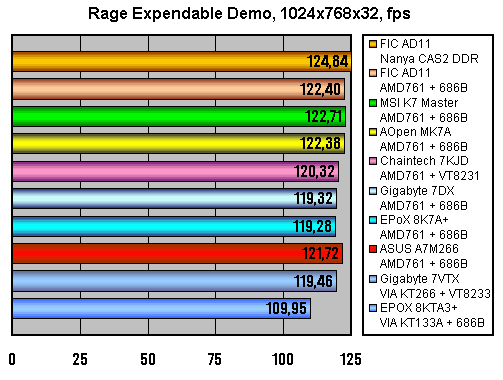 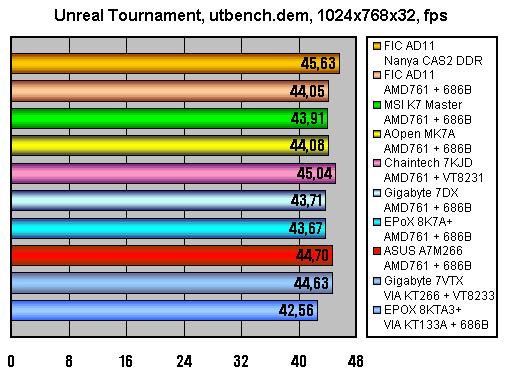 It is obvious that the AMD-760 wins from the KT133A, and as for the KT266, the situation is queer since we have only one board on this chipset, and a scatter of readings is not very huge and it can be explained by the inaccuracy of measurements. But on the whole, the AMD-760 is a leader, especially in the Expendable.  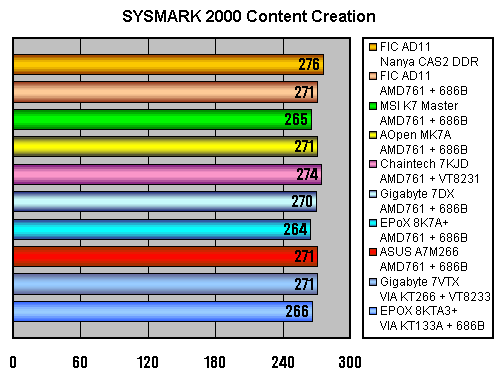 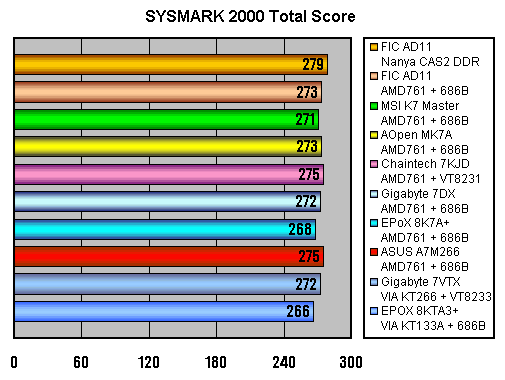 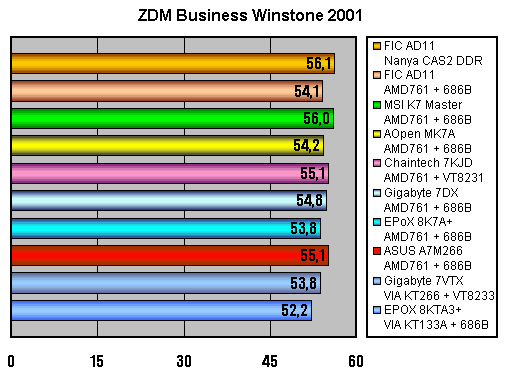 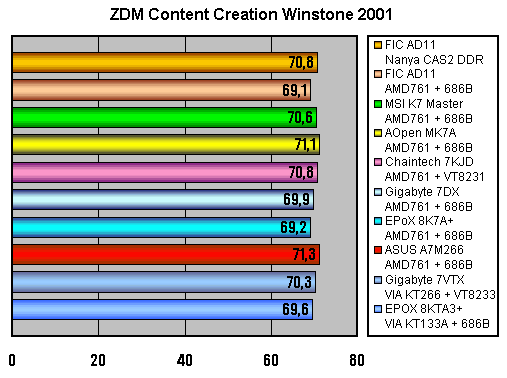 The KT266 lags behind the faster AMD-760 boards. By the way, a too little difference between the results of all systems in the SYSmark 2000 and Winstone 2001 makes me think that these tests have a great number of applications for which a power of the processor is much more critical than a speed of the subsystem "processor <-> memory". In everything where a memory access speed is enabled, the data on separate applications say much more.  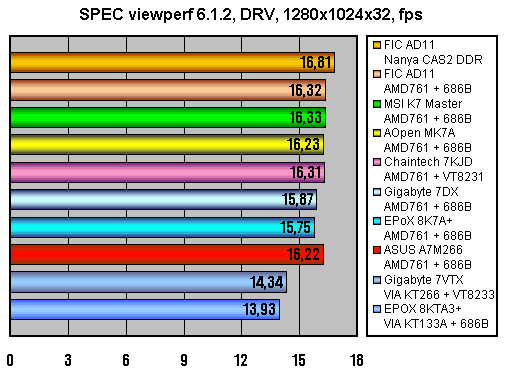 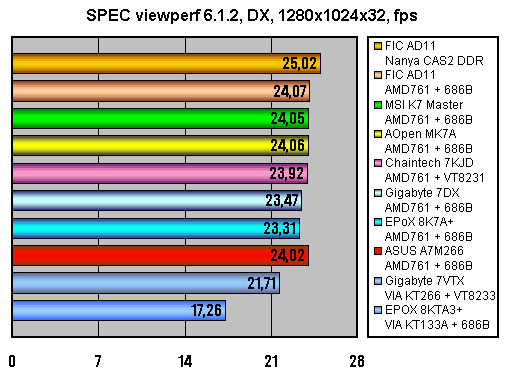 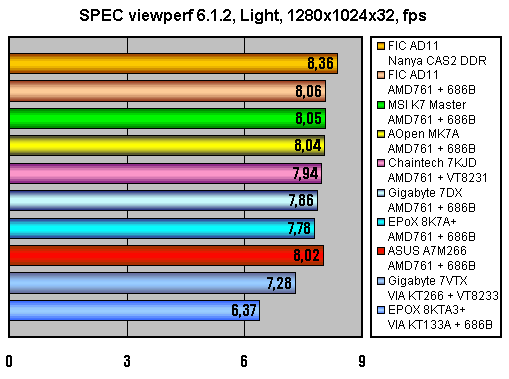 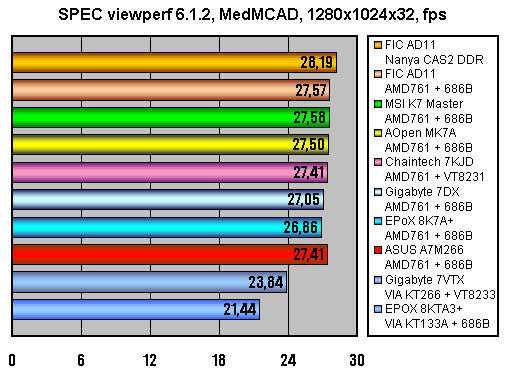 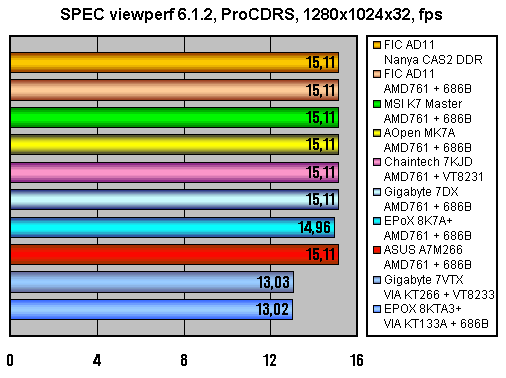 In the test packet SPEC viewperf 6.1.2 the AMD-760 wins sometimes by 20% (the AWadvs-04 test based on the Advanced Visualizer packet from Alias/Wavefront). We will speak primarily about two diagrams out of 6: with the results of the AWadvs-04 and the Light-04 (Lightscape Viewset), since in the AWadvs-04 the fastest board on the AMD-760 wins from the VIA Apollo KT266 (it is the Gigabyte 7VTX) by ~20% (the largest difference), and in the Light-04 - it wins again but with the lowest difference of ~14%. Let's look at each test to understand the results. 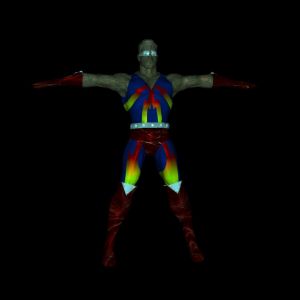 As you can see from the screenshot, in the AWadvs-04 test there is only one complex object that is rendered (a human figure looking like a Super Man), which consists of many polygons. Of course, the polygons are processed on the accelerator's level, but each rotation phase requires at least calculating its results, and this problem is exactly for the processor to solve. In fact we have the same situation as in the 3DMark 2001 "High detail" - an object is one but it's very complex. In this test the AMD-760 leads by the largest margin.  A complex lighting with a great number of light sources, large one-color planes. For more detailed information refer here, we will take from there only one phrase: "The most significant feature of Lightscape is its ability to accurately simulate global illumination effects". Taking into consideration the T&L block in the GeForce3, I can suppose that the heaviest load in the scene rendering is laid upon the accelerator. The KT266 in this test is not faster than in the AWadvs-04 - the chipset with the processor have much less work to do.  The 3DStudio MAX shows primarily the processor speed than that of the memory subsystem. Even the VIA KT133A has fallen behind the fastest AMD-760 board only by ~2%. It is not much. The AMD-760 has an excellent memory controller, and a troublesome AGP. It is strange, since a memory controller is much more complex device. VIA Technologies had the same problems with this bus until they and Intel benefited from each other. Nevertheless, something still might be done in order to increase speed of the AGP on the AMD chipsets on the level of the miniport-driver (GART). By the way, new versions of it are released rarely. Performance and summaryIf you need only the speed, then go with the FIC AD11. The board leads in the most of tests. Although the ASUS A7M266 beats it sometimes, on average the FIC AD11 is still ahead. A perfect stability, a great deal of features, a version with an integrated SCSI-controller and high quality of the MSI K7 Master makes this board a good basis for a graphics or CAD/CAM station. This board is intended for long, constant and intensive work. The ASUSTeK and Chaintech have not much to excel in, though the ASUS A7M266 takes the second position after the FIC AD11 in the performance. These boards are just good, quality and stable products. The GigaByte is disappointing in its ascetic character. The performance of the 7DX is not very high, but the stability proved to be very good. The AOpen is also poor in features and possibilities, besides, it has a mATX form-factor. The EPoX has released a traditional board - the UATA/100 IDE RAID and the onboard POST-card, maximum possibilities for making adjustments, especially when overclocking is concerned. However, I think there are some unnecessary features. As a result, we have a stable and overclocker-friendly board :) ConclusionAmong all DDR chipsets the AMD-761 has the fastest memory controller, and ensures the fastest interaction of the memory and the processor due to the SuperBypass option. The AGP realization quality yields to the KT266 and KT133A chipsets. I can't state unambiguously what has the say: the AGP controller or the AGP miniport which is rarely updated, but the VIA chipsets still suit game applications overloaded with textures than the AMD-760 does. In addition, a higher price of the chipset and a necessity in 6-layer PCBs makes the AMD-760 boards almost exclusive products. Together with top versions of the Athlons intended for the 266 MHz bus, a larger DDR memory size and a professional video, such system will perfectly suit a role of a workstation. In this case it will has both the best price/quality ratio and the highest performance, and will be well-balanced solution. So, a visualization of 3D scenes, CAD/CAM, video editing are what the AMD-760 systems are meant for. You might notice that the approach in developing
of AMD-760 boards' design are different. On the one hand (we consider
it right), we can see MSI and, to some extent, ASUS, which are offering
solutions for a good workstation. FIC stands in the middle with
its perfect performance, and Chaintech with its unusual but more
functional south bridge etc. AOpen amazed us with its mATX solution
which looks even more strange taking into consideration that a normal
full-size AMD-760 board is absent.
Write a comment below. No registration needed!
|
Platform · Video · Multimedia · Mobile · Other || About us & Privacy policy · Twitter · Facebook Copyright © Byrds Research & Publishing, Ltd., 1997–2011. All rights reserved. |